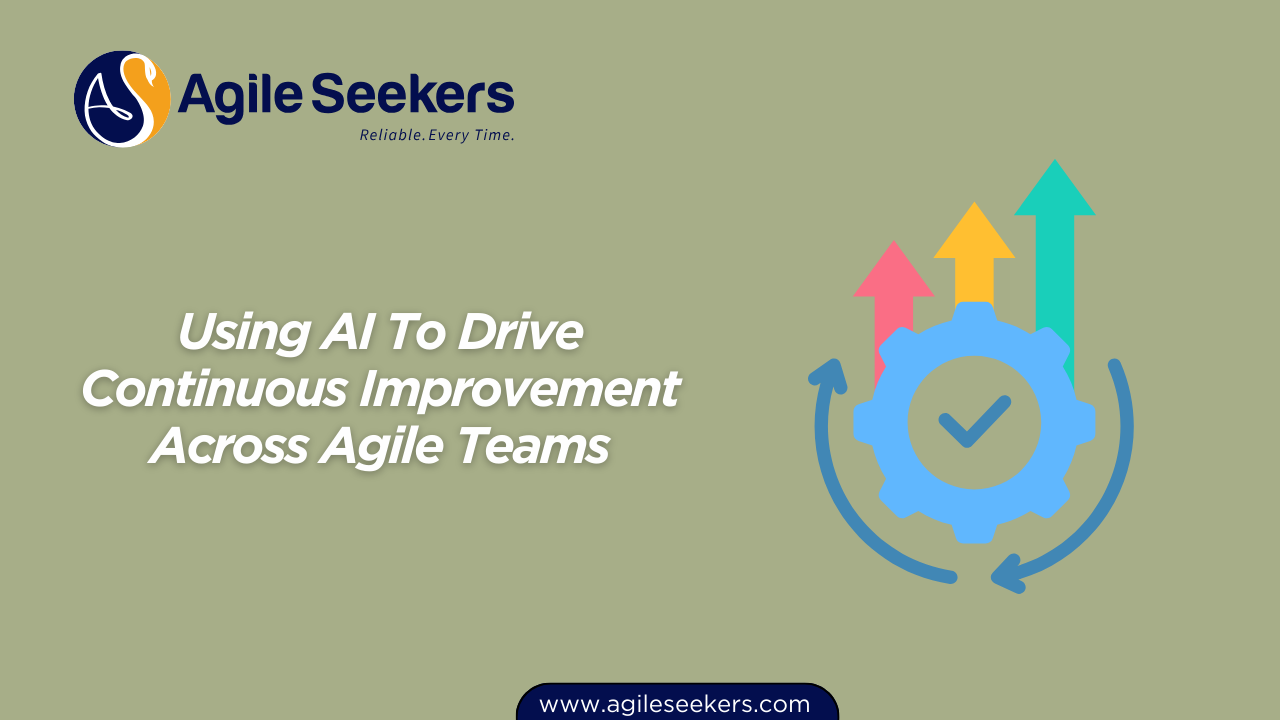Using AI To Drive Continuous Improvement Across Agile Teams

Continuous improvement is at the heart of Agile. The idea is simple: teams regularly inspect how they work, identify opportunities to improve, and then adapt. The execution, however, can be challenging—especially when the pace of delivery is high and priorities are constantly shifting.
This is where AI comes in. Not as a replacement for Agile thinking, but as a catalyst that helps teams identify patterns, act faster, and maintain a data-informed approach to improvement.
1. Why Continuous Improvement Needs a Boost
Agile teams often rely on retrospectives, sprint reviews, and feedback loops to improve. While these methods work, they’re limited by human memory, interpretation, and time. AI solves these gaps by:
-
Collecting and processing large volumes of data from sprint metrics, communication tools, and delivery pipelines.
-
Spotting trends and anomalies that might take teams weeks to notice.
-
Suggesting targeted improvements based on historical patterns.
Instead of waiting until the next retrospective, AI can surface issues in real time—allowing teams to course-correct before problems grow.
2. How AI Fits Into the Continuous Improvement Cycle
Continuous improvement in Agile generally follows three stages:
Observe → Learn → Adapt.
Here’s how AI amplifies each step:
Observe
-
AI-powered dashboards integrate Jira, Trello, or Azure DevOps data to track lead time, cycle time, and throughput.
-
NLP-based tools can scan team chat logs to detect recurring blockers or bottlenecks.
-
Sentiment analysis can highlight morale dips, giving Scrum Masters early warning.
Learn
-
Predictive analytics forecast the impact of current velocity on upcoming release dates.
-
Machine learning models can group recurring issues and show which ones have historically caused the most delays.
-
AI can correlate delivery patterns with customer feedback scores, revealing which improvements actually matter to end users.
Adapt
-
Automated recommendations for backlog prioritization based on cost of delay and customer impact.
-
AI-generated “what-if” simulations help teams test potential process changes before adopting them.
-
Knowledge retrieval tools can quickly surface relevant case studies, templates, or playbooks from past projects.
3. Practical AI Applications for Agile Teams
a) AI in Retrospectives
-
Tools like Miro AI and Parabol AI can automatically summarise retro discussions, highlight common pain points, and even suggest follow-up actions.
-
This helps prevent “action item amnesia” where identified improvements never make it into actual workflow changes.
b) Sprint Health Monitoring
-
AI monitors work-in-progress (WIP) limits and alerts teams when they’re close to overcommitting.
-
Real-time detection of bottlenecks in the development pipeline (e.g., QA delays, deployment failures).
c) Stakeholder Feedback Analysis
-
AI can digest thousands of customer comments, reviews, and survey results to identify the top improvement opportunities.
-
Instead of relying on anecdotal feedback, teams get a quantified view of user pain points.
d) Skills and Role Alignment
-
AI-powered skills mapping can detect mismatches between team workload and skill availability.
-
It can recommend training, pair programming opportunities, or role adjustments to increase delivery efficiency.
4. Linking AI to Agile Leadership
Adopting AI for continuous improvement isn’t just about plugging in a tool—it’s a leadership initiative.
Agile leaders need to ensure:
-
The team understands why AI insights are valuable.
-
Data is used to empower, not micromanage.
-
Improvement experiments are small, measurable, and fast to implement.
If you’re an Agile leader or change agent looking to integrate AI effectively, consider structured learning through AI for Agile Leaders and Change Agents Certification.
It covers practical strategies for bringing AI into decision-making, without losing Agile’s human-centric approach.
5. Challenges to Watch Out For
While AI can be transformative, there are risks if not handled well:
-
Data Quality Issues – Poor or incomplete data will lead to inaccurate recommendations.
-
Over-Reliance on Automation – AI should guide, not dictate. Teams still need to validate suggestions.
-
Change Resistance – Some team members may feel AI is a surveillance tool; transparency is essential.
Addressing these concerns upfront ensures smoother adoption and better outcomes.
6. External Resources Worth Exploring
-
State of Agile Report – Annual insights on Agile adoption trends and practices.
-
Agile Alliance Guides – Practical tips on retrospectives, feedback loops, and metrics.
-
Scrum.org Evidence-Based Management – A framework that pairs well with AI-driven measurement.
These resources can be paired with AI capabilities to create a more informed improvement process.
7. Measuring the Impact of AI on Continuous Improvement
To ensure AI is delivering value, track metrics before and after AI adoption:
-
Lead Time Reduction – Are features getting to users faster?
-
Quality Improvements – Fewer defects or post-release issues?
-
Team Satisfaction – Are morale and collaboration improving?
-
Business Outcomes – Is customer satisfaction or retention improving?
These measurements help teams confirm that changes are working, or pivot quickly if they aren’t.
8. The Future of Continuous Improvement with AI
Over time, AI will shift from being a support tool to a proactive advisor:
-
Real-time “nudges” to keep WIP under control.
-
Contextual learning that adapts to each team’s unique workflow.
-
Integration with OKRs and value delivery tracking to align improvements with strategic goals.
Continuous improvement will become less about scheduled reflection sessions and more about continuous learning in the flow of work.
Final Takeaway:
AI doesn’t replace Agile thinking—it strengthens it. When used well, AI becomes the always-on observer that spots patterns, flags risks, and suggests changes faster than traditional methods. The real transformation happens when teams take those AI insights and act on them quickly, making small, consistent improvements that compound over time.
Also read - Why Data Literacy Is Essential For AI Enabled Agile Leaders
Also see - AI Powered Coaching Techniques For Agile Transformation Leaders




















